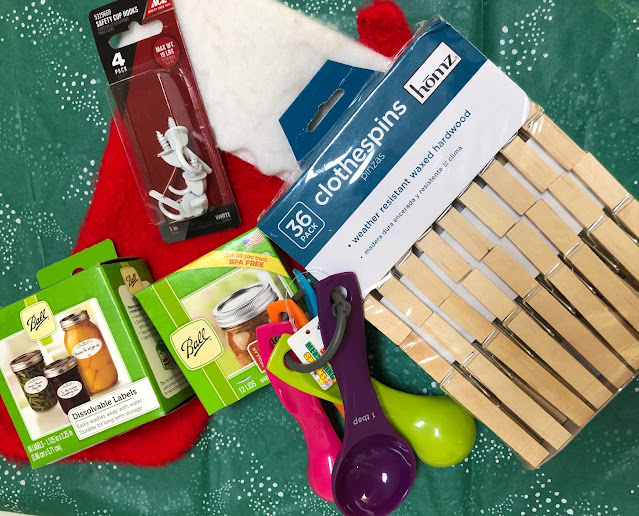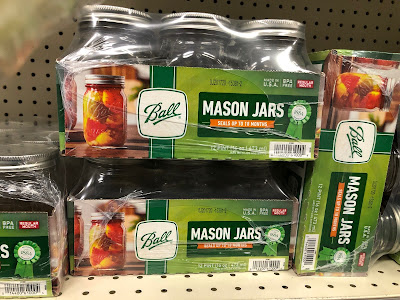
Useful gifts found beyond the garden department

|
|
These potential stocking gifts for gardeners all were found at hardware stores. (Photos: Kathy Morrison)
|
Experienced gardeners tend to be picky about their garden equipment. Pruning shears, gloves and amendments are personal choices.
But there are many items useful for gardening that are not sold in nurseries or garden departments. Here are some suggestions and the stores they're found in.
Hardware or big-box store:
Poly tarps -- These come in sizes starting at 4-by-6 feet and in various weights. I've found a medium-duty tarp with grommets along the reinforced edges is incredibly useful for such things as protecting the back of my car carrying straw bales; collecting and moving a pile of mulch or leaves; and harvesting worm castings. They can also protect outdoor furniture from any garden overspray.

|
| Buckets are endlessly useful and make good gift containers, too. |
Clear plastic sheeting -- Painters use this for protecting floors and furniture. It's ideal in the garden for soil solarization during warmer months. Be sure to get at least 1-mil thick but not thicker than 2-mil.
Weights -- We're not talking fitness weights here, but those could work in a pinch. Rocks work, too, but weights of various sizes can hold down sheeting, paper mulch, newspaper or whatever else on the ground you want to keep from blowing away, as least temporarily.
Painters tape -- The good stuff is worth the price. Blue or green, at least 1-1/2 inches wide, it's great for marking seedling containers, closing fertilizer bags and labeling used (but emptied) generic spray bottles (such as with "water only" or "rose fungicide").
Hammer -- The main use is obvious: to put together raised beds or trellises. But I've found the claw of a hammer invaluable for pulling up garden staples that hold down mulch cloth or drip irrigation lines.
Cup hooks -- These can be screwed into wood posts or a fence to help anchor a plant or vine with string or plastic ties.
Clothes pins -- My favorite use for these is clipping shade cloth to tomato cages, but they also are useful for closing bags of dry fertilizer or other paper containers. The wooden ones last longer than the plastic ones.
Office supply stores:
Sharpies and soft lead pencils -- For marking labels. I always have a Sharpie in my bucket of garden supplies. They're also crucial for marking spray bottles with formulas for mixing and for the contents. I also mark the bucket that I use to mix bleach solution. (See item under kitchen)
Stick-on paper labels -- They usually come in sheets or rolls. Use these to mark pots for seedling.
Plastic 6-inch or 12-inch ruler and a wooden yardstick -- The ruler is for measuring the depth of a hole or furrow for planting seeds or seedlings. A yardstick can ensure rows are straight and even.
Blank journals or spiral-bound notebooks -- Great for keeping track of what's been planted and when.
Craft store:
Craft sticks -- We used to call these "Popsicle sticks." Buy a big box (ice pops not included) at a craft store. They make cheap one-season plant or row markers.
Photo file boxes -- These were popular for storing snapshots when we all got film developed at the local drugstore. They're still sold for other storage and are ideal for stashing seed envelopes. They have a spot for a label, too.
Unfinished wooden signs -- These come in all sizes. Paint them to mark seed rows or just put a cheery sign in the garden. Use blackboard paint to make a reusable sign.
Kitchen supply department or supermarket:
Plastic scoops -- So useful for scooping potting soil into container plants or dry fertilizer anywhere.
Plastic measuring spoons and plastic measuring cups with spout (various sizes) -- For accurate measurements of fish emulsion and other liquid fertilizers.
Bottle of regular bleach -- Cleaning supplies are at a premium this year, so even a simple bottle of bleach is a welcome addition to the gardening shed supplies. A 1-to-9 bleach solution is recommended to disinfect used pots and containers, so any pathogens clinging there don't carry over to the next plants.

|
|
Canning jars were in demand this past summer. A case of
them would be welcome gift for a gardener who likes to
preserve the harvest.
|
If you can't decide:
-- Gift cards or certificates to one of the locally owned nurseries is always a good bet. And you help the local economy, too!
Comments
0 comments have been posted.Sacramento Digs Gardening to your inbox.
Sites We Like
Garden Checklist for week of May 12
Get your gardening chores and irrigation done early in the day before temperatures rise.
* Plant, plant, plant! It’s prime planting season in the Sacramento area. Time to set out those tomato transplants along with peppers and eggplants. Pinch off any flowers on new transplants to make them concentrate on establishing roots instead of setting premature fruit.
* Direct-seed melons, cucumbers, summer squash, corn, radishes, pumpkins and annual herbs such as basil.
* Harvest cabbage, lettuce, peas and green onions. This heat will cause leafy greens and onions to flower; pick them before they bolt.
* In the flower garden, direct-seed sunflowers, cosmos, salvia, zinnias, marigolds, celosia and asters.
* Plant dahlia tubers. Other perennials to set out include verbena, coreopsis, coneflower and astilbe.
* Transplant petunias, marigolds and perennial flowers such as astilbe, columbine, coneflowers, coreopsis, dahlias, rudbeckia and verbena.
* Keep an eye out for slugs, snails, earwigs and aphids that want to dine on tender new growth.
* Feed summer bloomers with a balanced fertilizer.
* For continued bloom, cut off spent flowers on roses as well as other flowering plants.
* Got fruit trees? If you haven't already done so, thin orchard fruit such as apples, peaches, pears, pluots and plums before they grow too heavy, breaking branches or even splitting the tree. Leave the largest fruit on the branch, culling the smaller ones, and allow for 5 to 6 inches (or a hand's worth) between each fruit.
* Thin grape bunches, again leaving about 6 inches between them. For the remaining bunches, prune off the "tail" end, about the bottom third of the bunch, so that the plant's energy is concentrated in the fruit closest to the branch.
* As spring-flowering shrubs finish blooming, give them a little pruning to shape them, removing old and dead wood. Lightly trim azaleas, fuchsias and marguerites for bushier plants.
* Add mulch to the garden to help keep that precious water from evaporating. Mulch also cuts down on weeds. But don’t let it mound around the stems or trunks of trees or shrubs. Leave about a 6-inch to 1-foot circle to avoid crown rot or other problems.